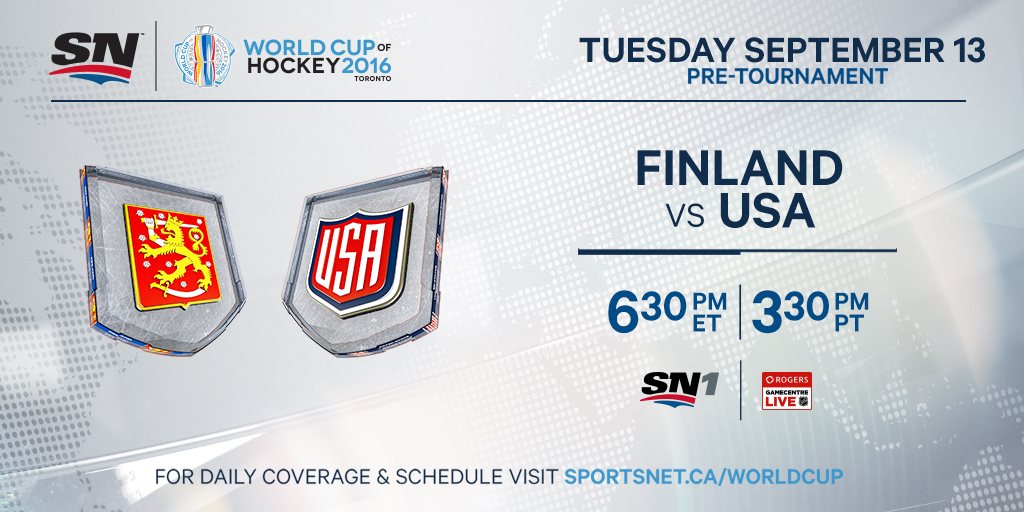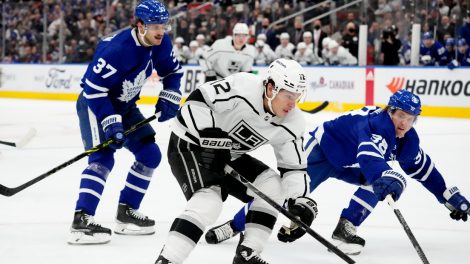The World Cup is just days away, and much of the recent buzz has been around Team North America. The new entry, made up of some of the game’s brightest young stars, has already beaten Team Europe in a pair of exhibition games.
They’re fast, they’re skilled, their uniforms are kind of cool, and they’re gaining credibility as a dark horse to make some noise, if not win the whole thing. It’s all led to talk that the Team North America concept, originally thought to be a one-time deal, could end up becoming a permanent fixture in future World Cups.
But today, let’s forget about the future and turn to the past, with what could make for a fun hypothetical: What if there had always been a Team North America? What if every Canada Cup and World Cup had featured a team of the best 23-and-under Canadian and American players of the day?
Let’s find out. We’ll go back over each of the seven Canada and World Cup tournaments, and figure out what a Team North America roster would have looked like.

First, some ground rules. We’ll use the same criteria that the 2016 tournament is using, meaning players have to be 23-or-under as of October 1 in the year the tournament is held. As with this year, we’ll allow players who don’t have NHL experience, but limit the roster to players who’ve at least been drafted.
As best we can, we’ll ignore the benefit of hindsight and try to go by a player’s reputation at the time of the tournament, meaning some late-blooming stars may be passed over. And to keep it simple, we’re going to pretend that everyone is healthy and available.
(All research for this post was conducted using the tools at the indispensable hockey-reference.com.)
We’ll count the seven teams down from worst to best. And as it turns out, that means we’ll begin at the beginning.
No. 7 – 1976
Up front: There are some recognizable names here, including Bryan Trottier, Lanny McDonald and Clark Gillies, but it’s not a star-studded group. Despite being in the middle of the record-breaking 70s, we’ve got only one 100-point scorer, and it’s Pierre Larouche.
The blue line: Denis Potvin is the big star here, not to mention the team’s best player. Ian Turnbull would be there too. And since the real-life teams decided to allow WHA players, we will too, which lets us scoop up Mark Howe.
In goal: There’s not a ton to choose from; we’re probably rolling with John Davidson as our starter and hoping we don’t need to turn to a backup.
Worth noting: This would really be a Team North America in name only; other than Howe, I’m not sure a single American would make the squad.
Overall outlook: They’d have been fun to watch, but there’s just not enough talent here to compete with the world’s best.
No. 6 – 2004
Up front: We have to go back over a decade for the last World Cup, which means we just miss out on the Sidney Crosby era. But we do pick get to include players from the ridiculously stacked 2003 draft, one that’s often considered one of the best ever.
The biggest name would be Rick Nash, who’d just won a share of the Rocket Richard as a teenager. He’d make a nice first-line combo with soon-to-be Senator teammates Jason Spezza and Dany Heatley. It gets thin after that, though, with big names like Joe Thornton and Vincent Lecavalier just missing the cutoff, and the team wouldn’t have a 60-point scorer.
The blue line: A solid group, one likely built around Jay Bouwmeester, Dan Hamhuis and John-Michael Liles.
In goal: In theory, this would be considered a strength, since you’d have the only two goalies since 1968 to go first overall in Rick DiPietro and Marc-Andre Fleury.
You’d likely see DiPietro as the starter, given that he was coming off a decent year and wouldn’t be widely considered a bust until a few years (and one big contract) down the road.
Worth noting: That 2003 draft class doesn’t end up helping as much as you’d think it would.
Patrice Bergeron makes the team, and maybe Dustin Brown does too. But future stars like Shea Weber, Ryan Getzlaf, Dion Phaneuf, Ryan Suter and Corey Perry were all still waiting to make their NHL debut, so it’s unlikely you’d see any of them on the team.
Overall outlook: It’s not a bad squad, but it’s impossible to look at it without thinking about how much better it would be if we’d have had even one more year to work with.
No. 5 – 1996
Up front: We’d start with a dynamic one-two punch on the first line, with both Eric Lindros and Paul Kariya coming off of 100+ point seasons. The supporting case would be decent, likely featuring Jason Arnott, Rob Niedermayer and Eric Daze, and you could use Michael Peca on a checking line.
The blue line: One of the better ones we’ll end up seeing. You could start with future Hall-of-Famers in Chris Pronger and Scott Niedermayer, then move on to a pair of recent first overall picks in Ed Jovanoski and Bryan Berard.
In goal: Martin Brodeur misses the cutoff by a few months, but that’s fine because we’ve got the reigning Vezina winner ready to go in… uh… Jim Carey. Hey, remember, we said no hindsight. And if Carey faltered, we could always turn to Chris Osgood.
Worth noting: While Shane Doan and Ryan Smyth would go on to make regular appearances on Canadian national teams, both would be borderline picks for this team.
Overall outlook: There’s plenty of talent here. As long as the goaltending holds up, they’d be competitive.
No. 4 – 1981
Up front: Wayne Gretzky is the big name; he’s already a two-time Hart Trophy winner at this point. The supporting cast is solid, with names like Mike Gartner, Denis Savard, Bobby Smith and Michel Goulet.
The blue line: Rookie Larry Murphy is your top offensive threat, and he’s joined by an all-around stud in Ray Bourque. That’s kind of it for the big names, although guys like Paul Reinhart and Rob Ramage would leave you with a solid core.
In goal: Goaltending won’t be a strength here, although you could say that for just about any team in the early 80s. You’re probably looking at Don Beaupre as your starter, maybe with Pat Riggin as the backup.
Worth noting: Can you sneak a 20-year-old Paul Coffey onto this team? Coming off a relatively uninspiring 32-point rookie season, I’m not sure you can.
Overall outlook: This isn’t a bad roster, and any team with Gretzky is going to be a challenge. But as we’ll find out, there were better days ahead for Team North America.
No. 3 – 1991
Up front: This is the first year that we really see the United States start to pull its own weight, as they can offer up Jeremy Roenick and Mike Modano, as well as Darren Turcotte and Jimmy Carson. That supplements some excellent Canadian talent, including Joe Sakic, Theo Fleury, Trevor Linden and Brendan Shanahan.
Oh, and an 18-year-old Lindros, who spent the real-life tournament crushing guys twice his age.
The blue line: There’s not the same depth of talent as there is up front, although we’ve got a legitimate number one in Brian Leetch and a future hall-of-famer in Rob Blake. After that, we’re probably looking at names like Zarley Zalapski, Matthieu Schneider and Yves Racine.
In goal: The good news: The reigning Vezina winner is a rookie who also finished third in MVP voting. The bad news: Ed Belfour got a late start to his career and misses the age cutoff. So instead, we’re looking at Tim Cheveldae, Jeff Hackett, and maybe even Peter Ing.
Worth noting: Total games played by qualifying American goalies in the 1990-91 season: One, by Damian Rhodes. (In case you’re wondering, Mike Richter was already 25 by now.)
Overall outlook: Of all the teams on our list, this one bears the most resemblance to the 2016 squad. There’s lots of firepower and the blue line is OK, but goaltending could be a weak point. In today’s world, that’s probably OK. In the high-flying early 90s, a sub-par goaltending group might spell doom.
No. 2 – 1987
Up front: It almost feels wrong to pull Mario Lemieux off of Team Canada, but rules are rules. He’ll be surrounded with plenty of talent, including Steve Yzerman, Luc Robitaille, Pat LaFontaine and Carson. And if you want to put together a crash line to stir things up, how about Cam Neely, Rick Tocchet and Wendel Clark?
The blue line: Pretty good. You’d have two established stars in Scott Stevens and Phil Housley, along with solid players like Steve Duchesne and Dave Ellett. And when it came time for the big showdown with Team Canada, we’d even have Gary Suter to neutralize Gretzky.
In goal: Ron Hextall would come in as the reigning Vezina and Conn Smythe winner, so he’s the starter. Patrick Roy is the backup, and Tom Barasso is your third-stringer. I’d say that’s pretty good.
Worth noting: OK, sure, none of Neely, Tocchet and Clark are centers. Are you going to tell them they can’t play together?
Overall outlook: This team is absolutely stacked, and would easily be one of the best Team North America squads ever assembled. Could they have beaten Canada or the Soviets? They’d be underdogs, but with an unstoppable Lemieux leading the way I think they’d have a shot.
No. 1 – 1984
Up front: Start with Gretzky, making his second Team North America appearance before finally graduating to Team Canada in 1987. Surround him with Oiler teammates Mark Messier and Glenn Anderson (who makes the cutoff by a single day), then add in Yzerman, Savard and Dale Hawerchuk. And just to stack the deck even further, let’s add Lemieux, fresh off of being drafted first overall.
There’s so much talent here that Barry Pederson, coming off a 116-point season at the age of 23, is an afterthought.
The blue line: The top three scoring defensemen in hockey are all on the team, with Paul Coffey, Ray Bourque and Phil Housley forming your core. You might also had ended up with Stevens, MacInnis and Murphy, although that may be some hindsight bias creeping in; it’s possible some of them could get bumped for older guys like Dave Babych or Moe Mantha.
In goal: Another Oiler gets the nod, as Grant Fuhr makes the roster. Even at 19 years old, reigning Vezina and Calder winner Barasso would challenge for the starting job.
Worth noting: If this roster looks familiar, it’s because it’s basically a big chunk of the actual Team Canada roster from that year’s tournament. And those guys won.
Overall outlook: You never want to discount the Soviets, who came within a Coffey poke check on winning it all that year. But with Team Canada stripped down, I’m willing to say that the 1984 Team North America squad wins the whole tournament.








